.
British Columbia License Plate Keytags

A special
thanks to Pierre Delacote for providing most
of the images found on this page.
Much of the historical information is based upon Kayce White's "The Tag Game", which appeared in the March-April, 1964 edition of BC Motorist.
At the conclusion of the Second World War, around 900 B.C. veterans came home via the wards of provincial tuberculosis (TB) sanatoriums. These former soldiers were untrained for civilian jobs and their ability to work after months or years in the hospital was questionable. Many also had young families to support and they could choose between finding an understanding employer who would tolerate their disabilities and train them, or accept social assistance. |
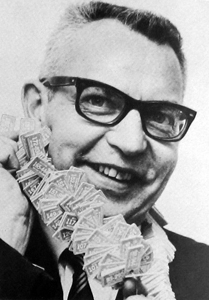
After repairing bridges under enemy fire, G. Roy Wilson laughs in the face of the threat posed by an anaconda like chain of TB Vets Keytags slowly constricting around his neck!
|
|
One of these soldiers was G. Roy Wilson, a sergeant with the Royal Canadian Engineers Field Company that had been stationed in Belgium. Wilson returned from Europe with a disability, a medal earned repairing on a pontoon bridge on the Leopold Canal under a barrage of mortar fire and no job. As Wilson recalled, “sure you’ve got a medal to prove you can repair floating bridges under fire, but there wasn’t too much call for that in downtown Vancouver.” |
Due to the nature of their disability these individuals required jobs that were not too physically demanding and that could provide a living wage that would help them bridge the gap between the battlefields, hospital wards and civilian life. Most of these veterans were receiving a disability pension, but “a man could grow weary waiting for a less then living stipend to come in”. What was required was a project to give these men a place and a reason to work. |
Along with other returned veterans, Bert Hunter and Ed Slater, Wilson struck upon the idea of keychain identification tags that would guarantee the return of lost keys to the owner. Thus, the Tuberculosis & Chest Disabled Veterans Association (TB Vets) of British Columbia was founded out of Branch 44 of the Royal Canadian Legion in 1946. |
Initial start-up costs were covered by a $4,000 loan from the Christmas Seal Society (which was repaid within a year), and as Legion Branches were prohibited from collecting funds for charitable causes, a charter was obtained from the provincial government. |
The service would be run as a sheltered workshop with a twofold purpose. Some disabled vets would be employed and others would benefit from funds raised by the project. |
In that first year, Wilson, Hunter and Slater would donate their time and work nights and weekends to send out the first 10,000 keychain tags — the design of which was a replication of the recipients actual British Columbia licence plate (complete with the same number). |
|
As Wilson later recounted, the funds raised would go to pay pension adjustment officers; provide immediate aid in the form of shoes, fares to get to jobs and groceries; to maintain a courtesy car to take patients to and from chest clinic appointments, transport young polio victims to and from school, and take “shut-ins” for drives. The funds raised also went to fund scholarships for the children of disabled veterans, to pay for equipment needed at the UBC School of Medicine, and to support senior citizens housing projects.
|
A little known aspect of the TB Vets work in the decades after the war was the arranging of funerals for deceased veterans. As Bert Hunter recalled in the mid-1960s, most people had no “idea how many people die in this town [Vancouver] without anyone to bury them … [kind of] reminds you of Dieppe …” |
By the mid-1960s, the Association was issuing a keytag to every registered motorist in the province, which was more than 600,000 people. The average donation at this time ranged between fifty cents to $1.00, with about 38% of recipients contributing. |
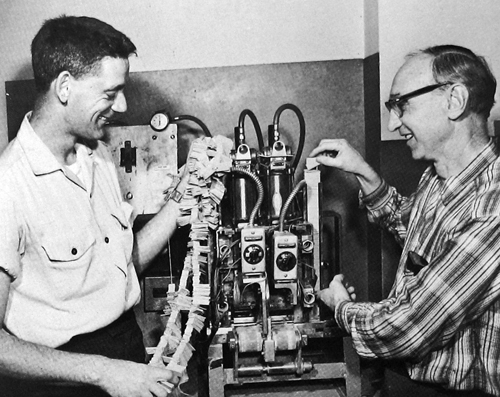 |
At left, two veterans display one of the machines used to create the keychain tags as well as another anaconda like chain of 1965 keytags. |
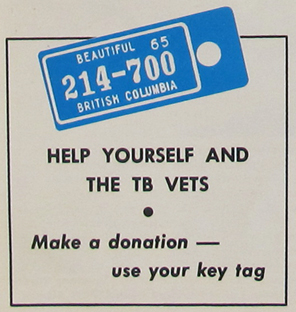
Above, an advertisement for the 1965 keytags. |
|
Due to the design of the keytags as miniature licence plates, the low return rate was chalked up to a perception that the tags were issued freely by the Motor Vehicle Branch (MVB). This was not the case and a constant problem for the Vets was that many people routinely made use of the program without contributing to the Association. |
One story that Wilson liked to recount was of a talk he gave to a community group, after which a member of the audience stood up and gave an account: |
of a fellow member who’d gone fishing with his wife at Gibson’s. She lost their car keys in the ocean. A scuba diver rescued them, noticed the key tag and sent them on to us. We returned the keys in good form. Someone asked whether the tag user had made a donation. ‘No’ said Wilson. ‘Well,’ said another member of the audience, ‘that was my wife.'
|
*
* * * * |
The
idea of a keychain tag service did not originate in British Columbia. In the United States, these types of tags had been in use as early as 1938 but were generally offered by private companies as a fee based on-request service. In 1941, the Disabled American Veterans (DAV) purchased the “Ident-o-tag” company and worked with the various state motor vehicle departments in order to gain access to the registration information of motorists across the country. |
|
The DAV would then mail tags to motorists in the shape of the licence plate from their state complete with their registration number. The basic premise of the program was based upon donations and, should someone’s keys be lost, the finder could drop them in a mailbox and the DAV would then return them to the owner. |
At the same time as the TB Vets were setting up shop in Vancouver, The War Amputations of Canada (War Amps) was initiating a similar keychain tag program out of Toronto. Despite a gentlemen’s agreement that was struck between the two Associations as they set-up their program which the TB Vets understood to reserve British Columbia as the exclusive territory, the War Amps strove to be national in scope (much like the DAV), and offered keychain tags in every province. As result, in 1946 & 1947 B.C. motorists had the choice of two keychain tag programs: |

TB VETS (1947) |

WAR AMPS (1947) |

WAR AMPS (1947 - Back) |
| |

WAR AMPS (1947) |
.jpg)
WAR AMPS (SPECIMAN?) |
|
Working against the War Amps was their location, as any set of keys lost by a motorist in Vancouver using a War Amps keychain tag would need to travel almost 9,000 km round-trip via Toronto. The War Amps were also confronted by a very effective marketing campaign in which the TB Vets encouraged British Columbians to use their service as it assisted local vets. As a result, the War Amps were never able to displace the TB Vets, who remain the only provincial organisation in Canada to continue to issue keychain tags? |
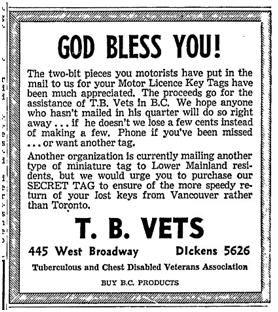 |
This advertisement (at left) from a 1956 newspaper underscores the rivalry that has existed between the T.B. Vets and the War Amps of Canada since the introduction of their competing "Key Tag" programs in 1946. |

Shown above is an example of the 1957 keychain tag the TB Vets were requesting motorists submit their $.50 for in the adjacent notice. |
|
Surprisingly, the rivalry between the two Associations exists over 65 years later, as TB Vets felt compelled to respond to a public criticism from The War Amps as recently as 2011. The War Amps alleged that TB Vets were “no longer a veteran organization in the sense of that word”. |
In their defence, the TB Vets pointed out that many of their volunteers are children and grandchildren of veterans, that the majority of their Board of Directors are affiliated with Branch 44 of the Royal Canadian Legion, and that they grant funds to local hospitals for respiratory ailments. |

War Amps - 1995 |
 War
Amps - 2004
War
Amps - 2004 |
|
| Collecting Keytags is not for the faint of heart! |
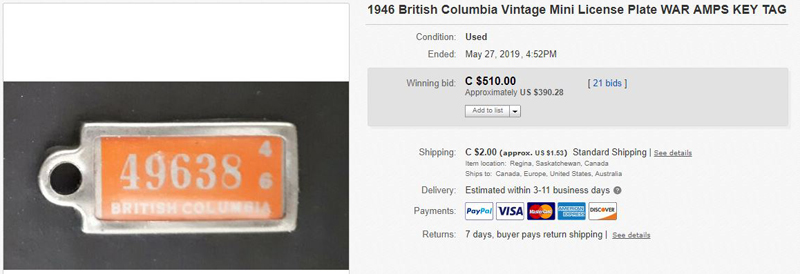
|
Early keytags from the TB Vets or War Amps are rare and not easy to come by. In 2019, a "First Year of Issue" (1946) came up for auction and went for a high price. While it is difficult to deduce much based on the two images from the auction it is interesting to note how the front of the insert appears to be virtually identical to the TB Vets design for 1946, but the tag holder and rear image seem to suggest that this is a War Amps keytag: |
|
|

TB VETS (1946) |
|
|
Until another 1946 War Amps keytag for BC presents itself it will be difficult to know if the No. 49638 is representative or is something else ... |
*
* * * * |
In the the late 1960s and early 1970s the TB Vets would annually publish promotional photos to encourage motorists to contribute to the organisation. As a result, there exist some great shots of Social Credit Party MLA Grace McCarthy and Tina the Elephant (from the Vancouver Zoo): |
*
* * * * |
In the 1970s, changing public perceptions regarding access to personal information retained by governments began to change and ultimately spelled the end of the DAV keychain tag program in the United States. In British Columbia, the TB Vets were able to retain access to the government data banks that contained the names and addresses of vehicle owners (as well as their licence plate information) due to the charitable work they had done since the 1940s along with their credible use of the information. |
Although access by the TB Vets to government data on was inconsistent with the trend towards increased protection of personal information, the government did not want to jeopardise Vets program. As a compromise, the Vets were required to change the type of information it displayed on the keychain tag. This was because it was becoming increasingly common for thieves who found a lost set of keys in a parking lot to simply look up and down the rows of parked vehicles in order to find the matching license plate number, and make off with the hapless owners' car. More often than not, the owners house keys would also be on the key ring, giving the thief the opportunity of letting himself into their home by simply looking up the address on the vehicle’s registration papers. By the time the owner realized his keys were missing, he may not have lost his car but perhaps some of his household possessions. Another problem that cropped up was that after the province moved to permanent licence plates in 1970 which were renewed by validation decal, some motorists did not feel the need to buy current keychain tags as their previous year’s tag already displayed their licence plate information and could be used to identify them. |
|
Given personalised license plates did not come out in BC until 1979, this is not a keytag for an actual license plate. Rather, it seems that the TB Vets were rather obliging of requests in the mid-1970s and made a number of these "BYNG" keytags for an individual collector. |
|
Starting in 1976, actual licence plate numbers were substituted for a coded number that only TB Vets staff could link to a particular vehicle and owner through a master list. With this change, the licence plate design was also substituted for a generic white tag that bore no resemblance to actual provincial licence plates. |
|
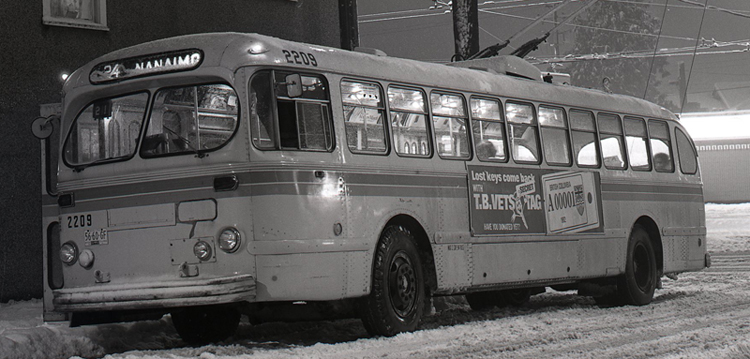 SEE THE BILLBOARD ON THE SIDE OF THE BUS (1982)
SEE THE BILLBOARD ON THE SIDE OF THE BUS (1982) |
For seven years between 1998 and 2004 the Vets keychain tags sported the design of the personalised licence plate, but this was discontinued as it was thought that the licence plate design did not project a modern image and that more visually attractive designs could be used to help increase donations. |
|
The design used on the 2012 keychain tag, for instance, is meant to represent “hope and freedom” and depicts a child holding a kite. The design also symbolises the work of Canadian soldiers in Afghanistan, some of whom are returning to British Columbia with the same respiratory diseases as their fellow soldiers from the World Wars. The kite is an item that many soldiers presented to children in Afghanistan but which was not approved of by the local Taliban forces. |
Over 400,000 sets of keys have been returned to British Columbians since the program was initiated in 1946, however, unlike the mid-1960s when every motorist in the province was sent a keychain tag, the TB Vets now send out only a mere fraction — 4.2% to be precise — to the 3,000,000 licenced drivers in the province. A failed business plan that saw the Association branch out into mail services, recognition products and coupon books in recent years was abandoned in 2011 due to the state of the economy, but at a cost. |
Many long-term employees, some with mental disabilities, who had manufactured the tags and hand-stuffed envelopes had to be let go. It also remains unclear as to where future keychain tags will be produced, but the Association is working to ensure that they continue to be made as they always have been in the “sheltered workshop” of the TB Vets office, and that former employees can brought back. |

© Copyright Christopher
John Garrish. All rights reserved.
|
|